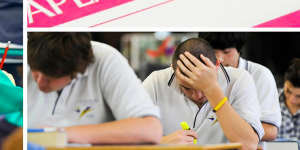Tens of thousands of students missed out on sitting the test in May,and the “historically low participation rates” have led the Australian Curriculum,Assessment and Reporting Authority to delay the release of preliminary NAPLAN data,which is normally published in August,warning it could not be relied on for accuracy.

NAPLAN was completed entirely online for the first time in 2022,but preliminary results have been delayed due to low participation rates.The Age
The preliminary data gives early insights into how students in each state and territory performed in reading,writing,spelling,grammar,punctuation and numeracy.
Low participation rates will not affect the results of those who did sit the test,and schools and parents can expect to receive their results in the next few weeks,ACARA said.
Education researcher at the Centre for Independent Studies,Glenn Fahey,said it was troubling that the authority had opted out of releasing the data,a move that could undermine participation in future years.
“As far as NAPLAN results go,no news is not good news,” he said.

“It would be a terrible outcome if system results remain unknown,as that could undermine the participation of those that took part,and could reduce the willingness to see the test through in the future.”
ACARA decided on Wednesday to delay releasing the data.
Participation rates ranged from a low of 85.2 per cent in year 9 numeracy to 95.6 per cent in the year 5 reading test.
The authority said participation rates were below the technical data standard of 90 per cent and would require further analysis.
“In light of the lower participation rates,closer analysis of results at a state and territory level needs to be done this year to ensure that the results adequately account for those lower participation rates,and that takes time,” ACARA chief executive David de Carvalho said.
Participation rates were down by 1 to 2 percentage points in primary schools and 2 to 3 percentage points in secondary schools.
De Carvalho said the significance of the degree of absenteeism this year affected the analysis.
About 1.2 million Australian students in years 3,5,7,and 9 took the literacy and numeracy tests at 9313 schools and campuses in May.
“In light of the lower participation rates,closer analysis of results at a state and territory level needs to be done this year.”
ACARA chief executive David de Carvalho
ACARA’s executive director of assessment and reporting Russell Dyer said a “conservative approach” was being taken because “we don’t want to announce a change that may turn out not to be significant”.
Dyer said he was not certain why secondary non-participation rates were higher than primary.
“We didn’t expect the level of non-participation. We knew schools were impacted by COVID,but we couldn’t predict what levels that they would be,” he said.
Schools were given a window of more than two weeks in which to complete the test in May,so that students in isolation would not miss out.
“We had a security period which allowed schools to try and catch up on students that may have been affected by COVID,flu and floods. And we thought that that would probably be enough,but there are significant declines in the participation,” Dyer said.
Victoria’s Education Minister,Natalie Hutchins,said the government was pleased students and schools will still receive their individual results in coming weeks,“but we want to ensure the integrity of national summary data before it is released”.
This year was the first time the annual NAPLAN assessments were completed entirely online,with 4.3 million tests done.
From next year,the national standardised tests will be completed in term one,instead of in May,so that results will be available to education authorities earlier.
All tests except the year 3 writing task were completed on computers for the first time,with online tests tailored to individual students,with the tests automatically adapting to a student’s test performance and asking questions that match their achievement level.
It is designed to give students and teachers more targeted and detailed data on students’ performance.
The test was cancelled in 2020 due to COVID-19. Last year’s NAPLAN results revealed that overall,NSW and Victorian students’ literacy and numeracy skills did not suffer because of lockdowns.
.
Cut through the noise of federal politics with news,views and expert analysis from Jacqueline Maley..